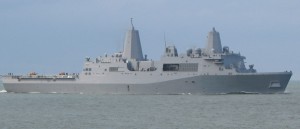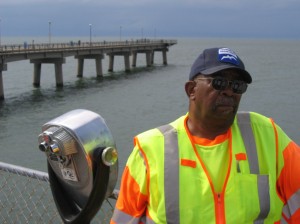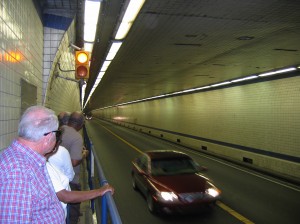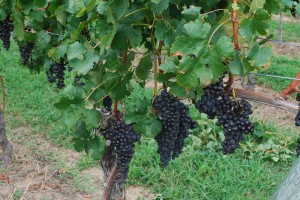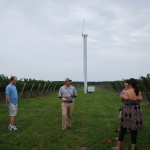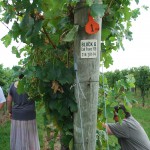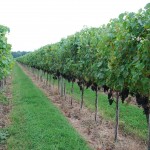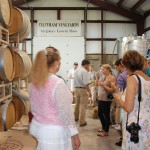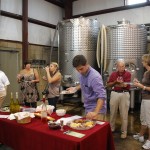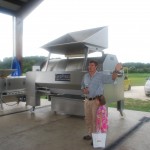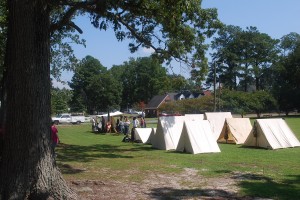
Re-inactment Camp In Parksley, VA Of The 2nd Delaware Volunteer Regiment Of The Union Army
Kudos to the Eastern Shore Public Library for sponsoring last week-end what may be one of the Eastern Shore’s best events commemorating the Sesquicentennial, the 150th anniversary of the beginning of the Civil War. Hosted as part of Heritage Week by the small Eastern Shore town of Parksley, VA, a re-inactment camp of the Union Army’s 2nd Regiment Delaware Volunteer Infantry, which has been an active re-inactment group since 1988, was held on the grounds of Parksley’s Town Park. Led by Captain Glenn Layton of Wyoming, Delaware, who became a member in 1996, the Regiment’s authentic period white tents were pitched in large green spaces ringed by sturdy hardwood trees, their leafy branches providing much appreciated shade. This was a three day event starting Friday evening September 9th and continuing through Sunday afternoon on September 11th, with many planned activities including a short observance of the 10th anniversary of 9-11.
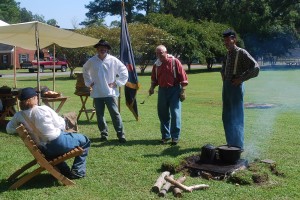
Just About Ready For Mess Call, Featuring A Savory Brown Bean Stew & Corn Bread
The Saturday morning schedule included a presentation of general aspects of day- to- day army life including pay call, no doubt as important then as today. My husband and I arrived just before noon, in time to see the demonstration of period cooking. Lunch was being prepared in a large cast iron dutch oven centered over the glowing coals of a wood fire, a fine smelling stew of plump brown beans bubbling away in a sauce seasoned with onion and ham hocks to be served with corn bread, followed by fresh apples for dessert. Troop satisfaction with the Company Cook seemed quite high and anticipatory speculation was circulating that roasted venison would be served for dinner along with a traditional apple crisp for dessert. Beverages consisted of water from individual canteens or cups of coffee from the huge pot set at the edge of the fire, only period messware was used ( tin cups, plates and utensils) , not a single ice cold coke in sight.
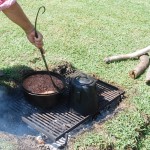
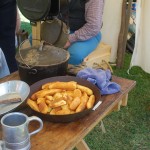
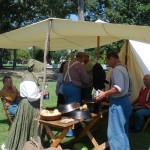
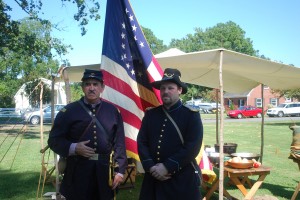
Capt. Glenn Layton (left) and Company Historian Prvt. Sean Protas of the 2nd Delaware Regiment
Shortly after lunch some close order drill and firing demonstrations were scheduled but before they began we were fortunate to be able to speak to the Company Historian, Private Sean Protas, who has forgotten more than I will ever learn about the 2nd Delaware and its various campaigns during the Civil War. At his day job, Sean Protas is an MBA and trust administrator. But by night, Private Protas is a diligent researcher, winkling out all sorts of interesting info on this Volunteer Regiment whose nickname was the ” Crazy Delaware’s” because of its unbelievable bravery and efforts to advance in the face of overwhelming odds at the Battle of Antietam. But some of the most interesting information about the 2nd Delaware to me was that the Regiment was involved in the Invasion of Accomac and Northampton Counties in November, 1861.
Although I am not a Civil War buff, I was truly embarrassed that after all the years I have lived here that I had never learned about the Union Invasion and subsequent Occupation of the Eastern Shore of Virginia. Preserving Civil War history through education is one of the primary goals of re-inactors and I surely got an education about the Civil War as it played out on the Eastern Shore by speaking with Private Protas. The Invasion began mid- November , 1861 and lasted for nearly a week, thereafter an occupation force of several thousand additional Volunteers from other newly trained units were moved to the Shore to maintain the peace. Union Regiments participating in the Invasion included the 5th New York, the 4th Wisconsin, 2nd Indiana and the 17th Massachusetts in addition to the 2nd Delaware. These units were selected because they had already had previous battle experience, being veterans of either the Battle of Bull Run or the Battle of Big Bethel. Although no Confederate troops had been stationed here, apparently the Shore was important to the Union army as part of its efforts to prevent easy travel to the south and to secure our many Atlantic Ocean and Chesapeake Bay inlets in order to blockade supplies to the Confederacy. So Pacification and Occupation of the Eastern Shore of Virginia was an important part of Union Army strategy. Makes sense, but who knew ?
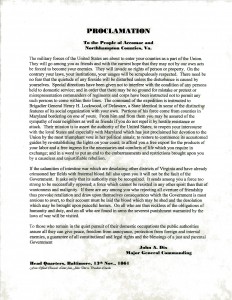 Two units from the 5th New York Regiment were even sent as far south as Cape Charles and beyond, although Camp Felicity, the Union Headquarters on the Eastern Shore, was located to the north on the Royal Felicity Farm, near what is now the town of Accomac, then called Drummondtown, relatively close to the Virginia-Maryland line. A Proclamation sent from Army Headquarters in Baltimore, Maryland, signed by Major General John A. Dix, was posted and read out in the Town Square, asking for Shore residents to co-operate with the Occupation, stating in part that unless the residents tried to repel the Army by “hostile resistance or attack” that “there need be no fear that the quietude of any fireside will be disturbed unless the disturbance is caused by yourselves.” Apparently it was obvious that the Occupation might be a lengthy one. Pvt. Protas gave me a copy of a letter written in December, 1861 from a Pvt. Brumley to his friend Eckel detailing life at Camp Felicity which comments: ” We shall soon have quite a society of ladies. The wife and daughter of our Colonial and the wife of one of the Captains are now in Camp. The Chaplain will soon have his family here. Then, with the 1200 men in barracks around us we shall form quite a village.” Apparently although some acts of rebellion occured and some tainted food was sold to Union soldiers, by and large, the Shore’s Occupation was without major incident, no doubt helping explain why the Eastern Shore still has so many historic homes dating back even to the 1700’s still standing .
Two units from the 5th New York Regiment were even sent as far south as Cape Charles and beyond, although Camp Felicity, the Union Headquarters on the Eastern Shore, was located to the north on the Royal Felicity Farm, near what is now the town of Accomac, then called Drummondtown, relatively close to the Virginia-Maryland line. A Proclamation sent from Army Headquarters in Baltimore, Maryland, signed by Major General John A. Dix, was posted and read out in the Town Square, asking for Shore residents to co-operate with the Occupation, stating in part that unless the residents tried to repel the Army by “hostile resistance or attack” that “there need be no fear that the quietude of any fireside will be disturbed unless the disturbance is caused by yourselves.” Apparently it was obvious that the Occupation might be a lengthy one. Pvt. Protas gave me a copy of a letter written in December, 1861 from a Pvt. Brumley to his friend Eckel detailing life at Camp Felicity which comments: ” We shall soon have quite a society of ladies. The wife and daughter of our Colonial and the wife of one of the Captains are now in Camp. The Chaplain will soon have his family here. Then, with the 1200 men in barracks around us we shall form quite a village.” Apparently although some acts of rebellion occured and some tainted food was sold to Union soldiers, by and large, the Shore’s Occupation was without major incident, no doubt helping explain why the Eastern Shore still has so many historic homes dating back even to the 1700’s still standing .
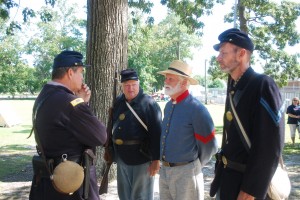
Capt. Layton Questions & Releases His Rebel Prisoner, Lowell Wallace, Upon His Honor To Commit No Further Misdeeds
After the history lesson from Pvt. Protas, we went over to observe the drill demonstration and then the arms inspection which included affixing bayonets and preparing muskets for firing. When watching these men tamp gunpowder into their muskets, one quickly realizes that many soldiers must have been shot during the extremely clumsy and slow process of simply re-loading. Just as the drill was being concluded, an unexpected and impromptu opportunity presented itself in the form of Confederate Commander Lowell Wallace of General Wises’ Refugees, a Son’s of Confederate Veterans group, which was staffing an information tent on the other side of the Park. He came over and spoke to Captain Layton about re-inacting the seizing and handling of a Rebel prisoner from the local populace, the prisoner obviously being Wallace. So the prisoner Wallace was chastised for his misdeeds and then released by Captain Layton after swearing on his honor not do so again. The entire Regiment, as well as Commander Wallace, then marched in close formation to the Confederate Monumont about three blocks away for a short ceremony honoring the dead on both sides and a 3 gun salute to the fallen.
After marching back to the Park, the next item on the Regiment’s agenda was re-inactment of a Court Marshall proceeding, to be presented from information obtained from official records of the actual Court Marshall of a 2nd Delaware private who, in 1861, had left his post without permission. Unfortunately, we had another engagement and were unable to stay longer so I’ll never know the fate of that unfortunate fellow but I did learn so, so much else. It seems really remarkable when one thinks about it, that back in a period when most people, over the course of their entire lifetimes, never even traveled beyond the borders of their own state, many never even beyond the borders of their own county, to have young men, Union soldiers, sent to fight on the tiny Eastern Shore of Virginia from such faraway states as Wisconsin and Indiana, New York and Massachusetts. And Delaware. E Pluribus Unum.

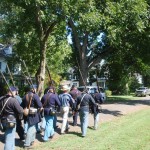
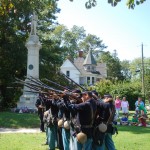
P.S. I was amazed at the uniforms which are wool, worn year-round. The uniform coat worn by Volunteers was called a “sack coat”, falling just below the hips and made of very, very tightly woven wool, lined with cotton or linen, pants were woolen, with headgear called a forage hat. Talk about hot, I can’t imagine how soldiers stood it all summer long. The regulation uniform coat worn by the Regular Army was called a “frock coat”, also wool and finished with decorative piping which matched the color of the cord on the hat ( called a hardee hat) — Infantry hats were decorated with a horn emblem with blue cord, yellow cord and a crossed sabers emblem for Cavalry and red cord with a crossed cannon emblem for Artillery units. In winter, troops wore a heavy woollen great coat which weighed about 10 pounds and reached below the knee, with a cape at the shoulders which could be pulled over the head in severe weather. As Pvt. Protas put it, the troops were way too hot in summer and way too cold in winter. And Pvt. Brumley’s letter to Eckel says: “Mittens are very much needed, so are stockings.” More information on the 2nd Delaware Regiment can be found on their website, www.2nddelaware.com
(Posted by Marlene Cree, licensed Virginia agent with Blue Heron Realty Co., 7134 Wilsonia Neck Dr., Machipongo, VA)

